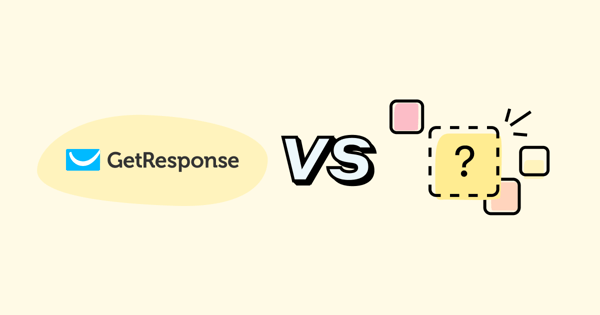GetResponse is one of the biggest names in email marketing.
With its complex automations, sophisticated list management, and exceptional email deliverability, it’s easy to see why GetResponse is the platform of choice for 350,000+ customers—including global brands like Ikea and Red Bull.
So is it the best option for your next email marketing tool? Possibly.
Sure, GetResponse is great. But there’s no shortage of quality GetResponse alternatives out there.
To help you find the right one for your business, we’ve rounded up 10 of the best alternatives to GetResponse and compared them across the following criteria:
- Price
- Product features
- Customer support
- Pros and cons
- Target audience
Let’s dive in…
What Are the Best GetResponse Alternatives?
| GetResponse Alternatives | Best For | Top Features | Pricing/Month |
| Drip | DTC ecommerce | Segment your whole audience based on real-time store, visitor, and marketing data. | From $39 per month for up to 2,500 contacts and unlimited email sends. |
| Klaviyo | Ecommerce agencies and developers | Personalization and segmentation tools allow you to create customer segments based on real-time data. | Free for up to 250 contacts and 500 monthly email sends; paid plans priced from $20 per month for up to 500 contacts and 5,000 monthly email sends. |
| Mailchimp | Small businesses | Advanced analytics and reporting help marketers make data-driven decisions. | Free for up to 500 contacts and 1,000 monthly email sends; paid plans start at $13 per month for 500 contacts and 5,000 monthly email sends. |
| Omnisend | Ecommerce marketers | Web push notifications allow brands to instantly retarget customers. | Free to reach up to 250 contacts per month, including 500 monthly email sends, up to 60 SMS messages, and up to 500 web push notifications. Paid plans start at $16 per month to reach up to 500 contacts (including unlimited push notifications). |
| Brevo (FKA Sendinblue) | Low-budget email marketing | Send transactional emails with guaranteed 97 percent deliverability. | Free for unlimited contacts and up to 300 emails per day. Paid plans start at $25 per month for unlimited contacts and 20,000 emails per month. |
| ConvertKit | Content creators | Integrated newsletter referral program helps creators grow their reach by leveraging their existing audience. | Free for up to 1,000 subscribers and unlimited email sends; paid plans start at $9 per month for up to 300 subscribers and unlimited sends. |
| ActiveCampaign | Advanced marketers who need high-level automation | Predictive actions use machine learning to deliver customer experiences based on data, such as the best time to send emails. | From $29 per month for one user and unlimited emails. |
| AWeber | Startups and small businesses | Create email templates in seconds using your website or Facebook page URL. | Free for up to 500 email subscribers and 3,000 monthly email sends; paid plans priced from $16.15 per month for up to 2,500 subscribers. |
| Constant Contact | Nonprofits and charities | Manage campaigns on the go from a dedicated mobile app. | From $12 per month for up to 500 contacts and 5,000 monthly email sends. |
| HubSpot | B2B inbound marketing | Connect marketing, sales, content management, and customer service in a single platform. | Free marketing plan includes unlimited contacts and 2,000 monthly email sends. Paid marketing plans start at $18 per month for 1,000 contacts and 5,000 monthly sends. |
The 10 Best GetResponse Alternatives
1. Drip
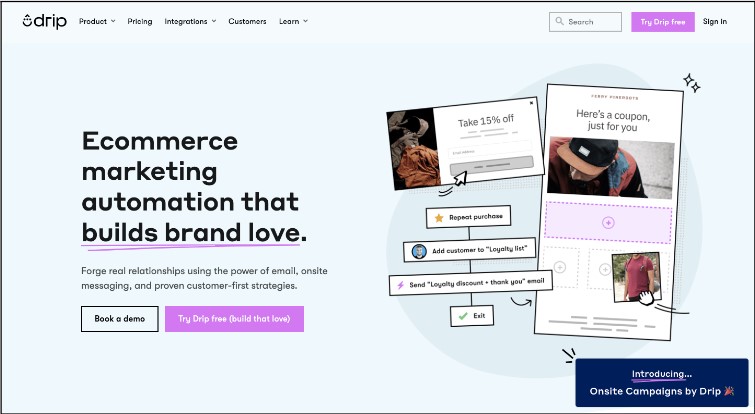 Drip (that’s us, btw) is a marketing automation platform built for ecommerce, with a particular focus on direct-to-consumer brands. Our pre-made workflows and intuitive point-and-click editor make it quick and easy to build email and onsite campaigns without requiring any coding skills.
Drip (that’s us, btw) is a marketing automation platform built for ecommerce, with a particular focus on direct-to-consumer brands. Our pre-made workflows and intuitive point-and-click editor make it quick and easy to build email and onsite campaigns without requiring any coding skills.
What Makes Drip the Best GetResponse Alternative?
- Built for ecommerce. GetResponse offers a ton of ecommerce functionality. But because it’s not a dedicated ecommerce platform, it also does a ton of other stuff (some of which isn’t relevant to ecommerce brands). With Drip, ecommerce is everything we do, so our whole platform is built around helping you generate sales and revenue.
- Developed for ecommerce. Because GetResponse serves businesses in multiple industries, its development plans need to factor in a diverse range of requirements. That’s not the case with Drip, where every new development we introduce—whether it’s a tool, a feature, or an integration—is built with ecommerce in mind.
- Sophisticated onsite marketing. Again, GetResponse’s forms and popups are excellent—they’re just not designed for ecommerce. At time of writing, it doesn’t offer dedicated ecommerce functionality like recommended product popups. At Drip, our acquisition of Sleeknote—an ecommerce form and popup builder—gives us unparalleled onsite functionality, allowing you to create on-brand popups, sidebars, and slide-ins designed around common ecommerce actions and scenarios (like upsells and product recommendations).
- Clutter-free interface. Because ecommerce is our whole thing, our UI makes it easy to find all the tools and reports you need to build and optimize revenue-focused campaigns. There’s nothing wrong with GetResponse’s interface; it’s just a little busier (and its editor can be a little clunky).
- Ecommerce-centric customer support. Did we mention that ecommerce is our sole focus? Well, because of that, our support team understands what amazing ecommerce marketing looks like—and we’re happy to share the wealth. We’ll pull up a chair, dig into your marketing plan, and offer strategic recommendations tailored to your brand. By contrast, GetResponse doesn’t even offer over-the-phone support unless you buy its premium plan.
- Cheaper ecommerce plans. At first glance, GetResponse looks cheap. But if you’re in ecommerce, you’ll need to upgrade to its Ecommerce Marketing plan (priced from $119/month) to access stuff like abandoned cart recovery workflows and product recommendations. Drip offers those features as standard, however much you pay us.
How Does Drip Compare to GetResponse?
| Drip | GetResponse | |
| Best Feature | Segment your whole audience based on real-time store, visitor, and marketing data. | Built-in GPT-3.5-powered email generator. |
| Best For | DTC ecommerce | Small businesses that need advanced marketing tools |
| Pros | A dedicated ecommerce platform, not a generalist tool; more affordable ecommerce functionality. | Has a free plan; a better choice for non-ecommerce businesses. |
| Cons | If you’re not in ecommerce, Drip isn’t the best fit. | Limited customer support at lower price tiers; onsite tools lack ecommerce functionality. |
| Pricing/Month | From $39 per month for up to 2,500 contacts and unlimited email sends. | Free for up to 500 contacts and 2,500 monthly email sends. Paid plans start at $13.30 per month for 1,000 contacts and unlimited email sends. |
| Support | Our support is rated 8.8 on G2 (vs. an average of 8.6 for marketing automation platforms) and includes live audio screen sharing to solve problems in real time. | Paid plans include 24/7 support via chat and email. Phone support is only available at top-tier MAX2 level; some MAX2 customers can also access Slack support. |
2. Klaviyo
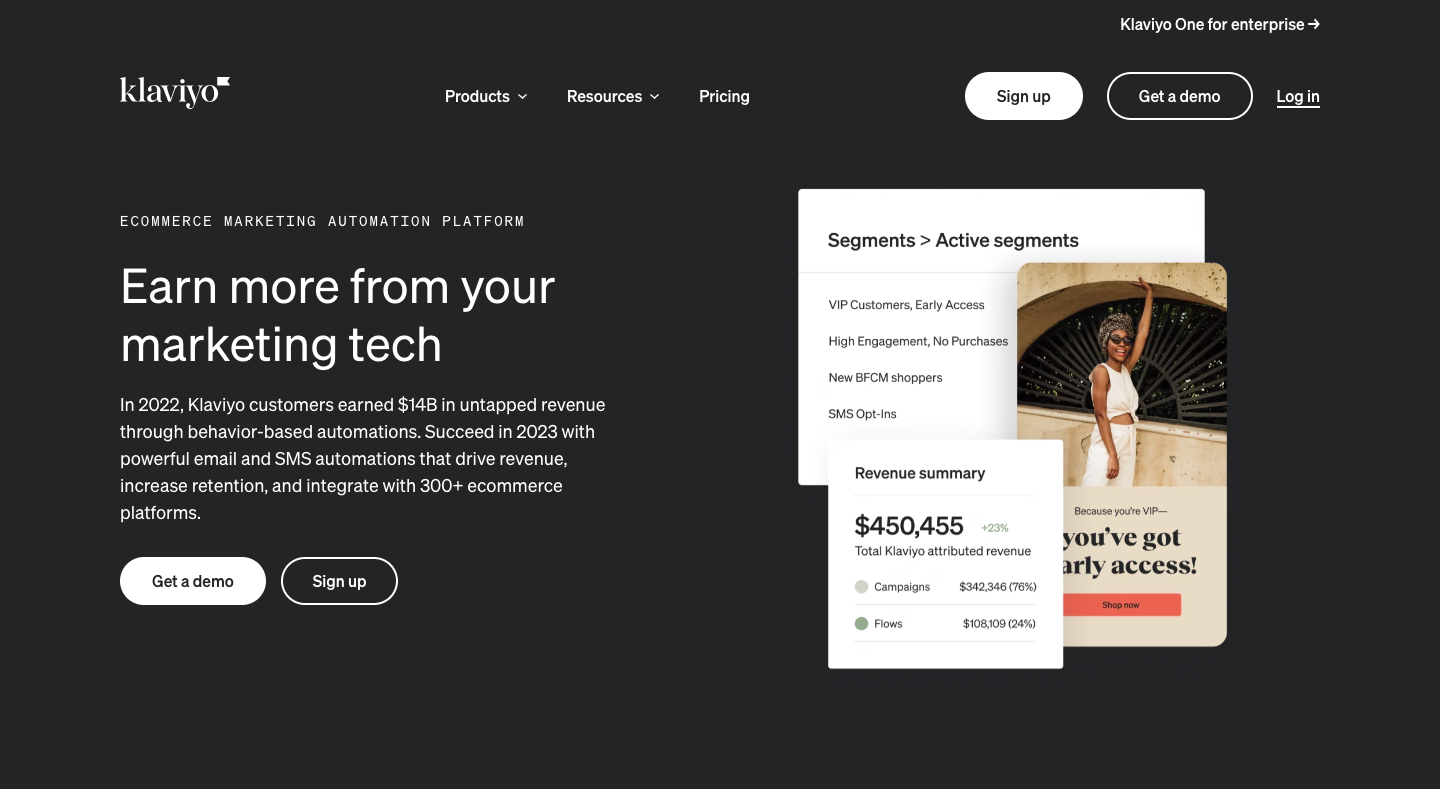 Klaviyo is another ecommerce marketing automation platform, although it targets a slightly different audience to Drip: you’ll need to employ a full-service agency or an in-house dev team to use it properly, so it’s not what we’d call a do-it-yourself solution. That makes it a better choice for big brands. So how does it compare to GetResponse, another tool with a host of enterprise-level customers?
Klaviyo is another ecommerce marketing automation platform, although it targets a slightly different audience to Drip: you’ll need to employ a full-service agency or an in-house dev team to use it properly, so it’s not what we’d call a do-it-yourself solution. That makes it a better choice for big brands. So how does it compare to GetResponse, another tool with a host of enterprise-level customers?
What Makes Klaviyo the Best GetResponse Alternative?
- Dedicated to ecommerce. Again, if ecommerce is what you do, you’re better off picking a dedicated platform like Klaviyo than an all-rounder like GetResponse.
- Built-in SMS marketing on all plans. GetResponse only offers built-in SMS marketing on its top-tier MAX2 plan, which has custom pricing (i.e. it’s expensive). With Klaviyo, you get free SMS/MMS credits on all plans, while dedicated email and SMS plans start at just $45/month.
- More affordable ecommerce functionality. Okay, this one’s muddied by the fact that you’ll need an agency or in-house dev capabilities to use Klaviyo effectively. But provided you’ve got those things, Klaviyo’s ecommerce plans are cheaper than GetResponse, which locks away important ecommerce features (like transactional emails and ecommerce segmentation) in its Ecommerce Marketing plan, priced from $119/month.
- More ecommerce templates. Both platforms offer 100+ email templates, but not all of GetResponse’s are relevant to ecommerce brands. So if ecommerce is what you do, Klaviyo’s templates are more useful.
- More integrations. Klaviyo offers 300+ prebuilt integrations,whereas GetResponse “only” has about 180. Sure, there’s nothing obvious missing from GetResponse’s integration library, but if this is a numbers game then Klaviyo is the clear winner here.
How Does Klaviyo Compare to GetResponse?
| Klaviyo | GetResponse | |
| Best Feature | Personalization and segmentation tools allow you to create customer segments based on real-time data. | Built-in GPT-3.5-powered email generator. |
| Best For | Ecommerce agencies and developers | Small businesses that need advanced marketing tools |
| Pros | Offers SMS marketing and ecommerce functionality on all price plans. | More generous free plan; a better fit for non-ecommerce businesses. |
| Cons | Requires advanced technical skills (or, ideally, a full-service Klaviyo agency) to use it effectively. | Charges a lot of money for essential ecommerce functionality. |
| Pricing/Month | Free for up to 250 contacts and 500 monthly email sends; paid plans priced from $20 per month for up to 500 contacts and 5,000 monthly email sends. | Free for up to 500 contacts and 2,500 monthly email sends. Paid plans start at $13.30 per month for 1,000 contacts and unlimited email sends. |
| Support | After the extensive onboarding program, support is limited to live chat and emails. | Paid plans include 24/7 support via chat and email. Phone support is only available at top-tier MAX2 level; some MAX2 customers can also access Slack support. |
3. Mailchimp
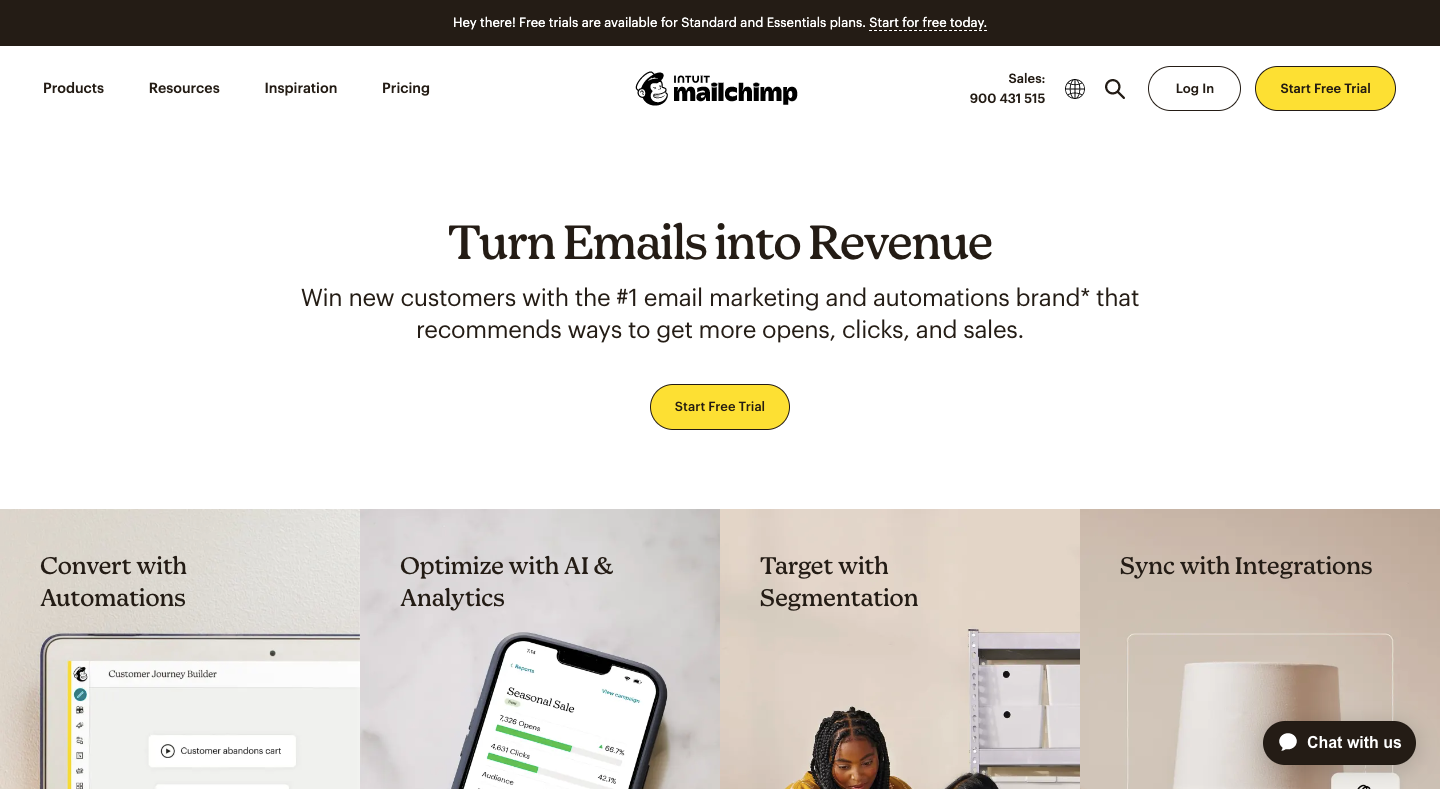 Mailchimp is one of the oldest, largest, and best-known email marketing tools, with over 12 million customers using the platform. Of course, that doesn’t automatically make it the best tool. Let’s see how it stacks up against GetResponse…
Mailchimp is one of the oldest, largest, and best-known email marketing tools, with over 12 million customers using the platform. Of course, that doesn’t automatically make it the best tool. Let’s see how it stacks up against GetResponse…
What Makes Mailchimp the Best GetResponse Alternative?
- Easier to pick up and go. To be fair, both platforms are pretty user-friendly, but Mailchimp—with its intuitive navigation and simple drag-and-drop editor—is slightly simpler for newbies to get to grips with.
- More detailed analytics. Again, both tools offer excellent analytics packages, but Mailchimp—with its built-in social media reporting—has a slight edge here.
- Integrate with more tools and apps. Mailchimp claims to offer 300+ integrations, which is significantly more than GetResponse (although, again, you shouldn’t be short on options with either platform).
How Does Mailchimp Compare to GetResponse?
| Mailchimp | GetResponse | |
| Best Feature | Advanced analytics and reporting help marketers make data-driven decisions. | Built-in GPT-3.5-powered email generator. |
| Best For | Small businesses | Small businesses that need advanced marketing tools |
| Pros | More reporting options and integrations. | Cheaper pricing for a comparable feature set (in fact, GetResponse is better in some areas, such as design testing and email deliverability). |
| Cons | More expensive, without truly justifying the price tag. | If you really need built-in social media reporting, GetResponse doesn’t have it. |
| Pricing/Month | Free for up to 500 contacts and 1,000 monthly email sends; paid plans start at $13 per month for 500 contacts and 5,000 monthly email sends. | Free for up to 500 contacts and 2,500 monthly email sends. Paid plans start at $13.30 per month for 1,000 contacts and unlimited email sends. |
| Support | Paid plans include 24/7 support via chat and email. Phone and priority support is only available to Premium customers paying $350+ per month. | Paid plans include 24/7 support via chat and email. Phone support is only available at top-tier MAX2 level; some MAX2 customers can also access Slack support. |
4. Omnisend
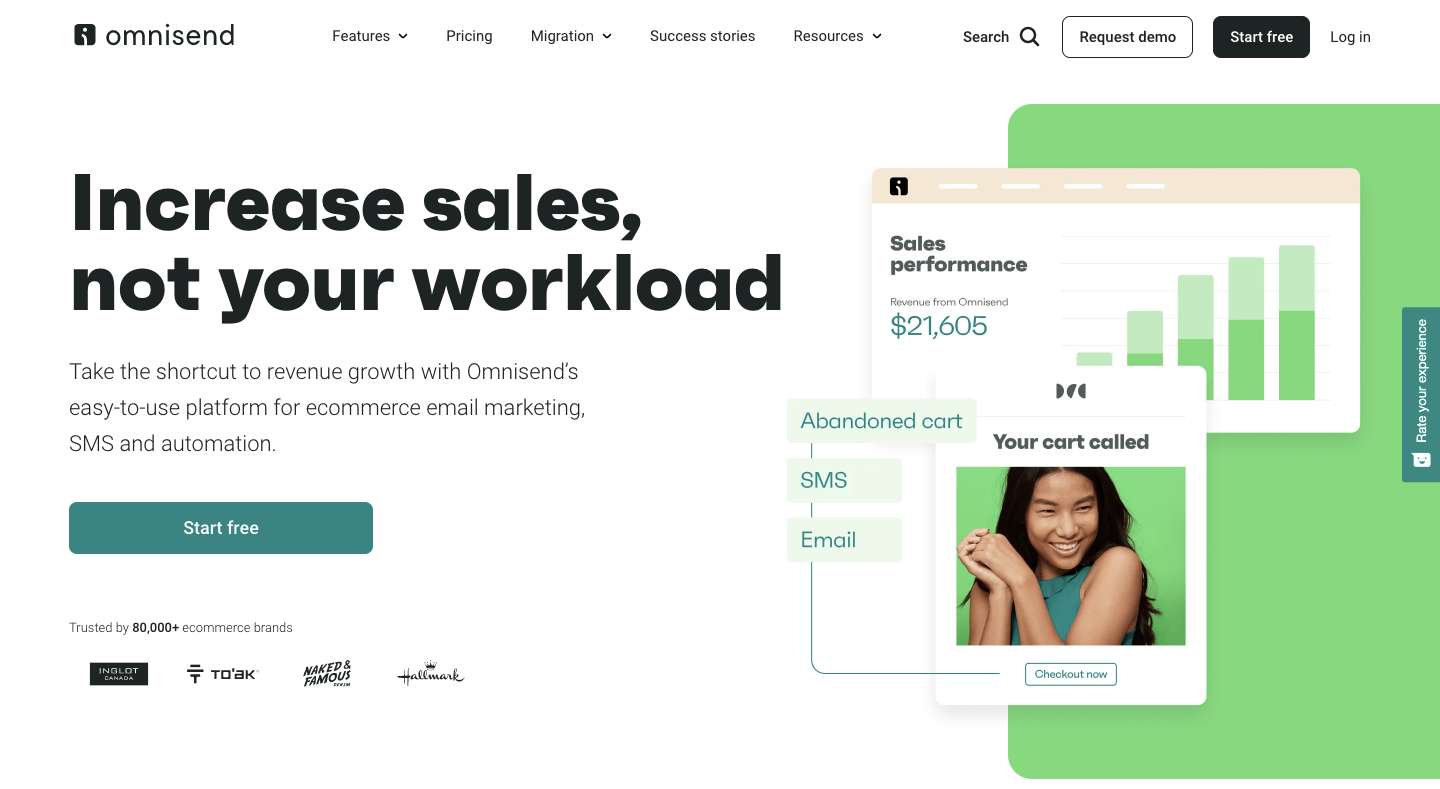 Like Drip and Klaviyo, Omnisend is a marketing platform built with ecommerce brands in mind, giving them the power to automate their email, SMS, and push notification campaigns. Over 100,000 businesses use Omnisend, giving it a similar customer base to GetResponse. But which is best?
Like Drip and Klaviyo, Omnisend is a marketing platform built with ecommerce brands in mind, giving them the power to automate their email, SMS, and push notification campaigns. Over 100,000 businesses use Omnisend, giving it a similar customer base to GetResponse. But which is best?
What Makes Omnisend the Best GetResponse Alternative?
- Free SMS & push notifications. Omnisend doesn’t have the most generous free plan in the email marketing world (generally speaking, GetResponse’s is better). However, it does offer some interesting extras, including up to 60 SMS messages and 500 web push notifications per month. GetResponse doesn’t include either of those in its free plan.
- Affordable SMS marketing. Not only does Omnisend offer (limited) SMS capabilities with its free plan, but it also allows customers to send thousands of SMS messages per month on its Pro plan, which starts at just $59/month. By contrast, GetResponse only offers SMS marketing with its top-tier MAX2 plan, which has custom (i.e. expensive) pricing.
- Automation for everyone. Even free Omnisend users can leverage the platform’s marketing automation capabilities, whereas GetResponse only makes automation available to customers paying $59+ per month.
How Does Omnisend Compare to GetResponse?
| Omnisend | GetResponse | |
| Best Feature | Web push notifications allow brands to instantly retarget customers. | Built-in GPT-3.5-powered email generator. |
| Best For | Ecommerce marketers | Small businesses that need advanced marketing tools |
| Pros | Advanced functionality (like automations and SMS marketing) available to all users. | Generally cheaper prices (provided all you want is the ability to send emails); a better fit for non-ecommerce businesses; more generous free plan. |
| Cons | If you’re not in ecommerce, you’re better off with a more generalist tool. | Charges more for marketing automation. |
| Pricing/Month | Free to reach up to 250 contacts per month, including 500 monthly email sends, up to 60 SMS messages, and up to 500 web push notifications. Paid plans start at $16 per month to reach up to 500 contacts (including unlimited push notifications). | Free for up to 500 contacts and 2,500 monthly email sends. Paid plans start at $13.30 per month for 1,000 contacts and unlimited email sends. |
| Support | All users get 24/7 email and live chat support, while Pro and Enterprise subscribers also get a dedicated customer success manager. | Paid plans include 24/7 support via chat and email. Phone support is only available at top-tier MAX2 level; some MAX2 customers can also access Slack support. |
5. Brevo (FKA Sendinblue)
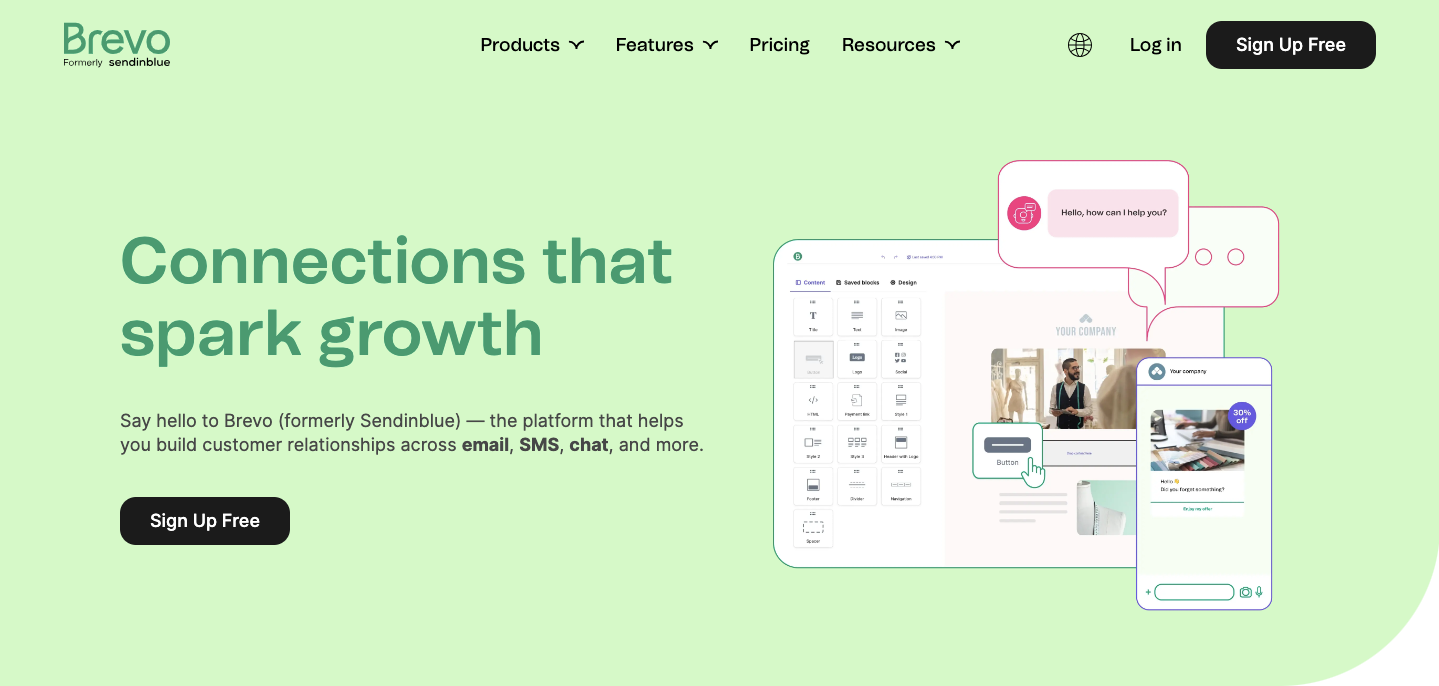 Brevo, formerly known as Sendinblue, is an email marketing platform that’s high on features yet low on cost. Its affordability has helped the company sign up over half-a-million customers across 180 countries.
Brevo, formerly known as Sendinblue, is an email marketing platform that’s high on features yet low on cost. Its affordability has helped the company sign up over half-a-million customers across 180 countries.
What Makes Brevo the Best GetResponse Alternative?
- Superb free plan. GetResponse’s free plan is pretty decent, but it can’t compete with Brevo, which lets you send up to 300 emails a day—including transactional emails—without spending a single cent.
- Cheaper for large list sizes. Unusually, all Brevo plans (even the free one) give you an unlimited contact list, making it an extremely affordable choice for brands with huge email lists.
- Built-in SMS marketing on all plans. As we’ve already noted, only the highest-paying GetResponse customers get access to SMS marketing, whereas Brevo offers it across all plans.
- Inclusive transactional emails. Transactional emails—like order confirmations and shipping notifications—are vital for ecommerce brands, and Brevo includes them as part of your standard email allocation. With GetResponse, you need to pay for a dedicated ecommerce plan ($119/month) to access transactional emails.
- Free CRM. Brevo’s Sales Platform includes a free CRM including unlimited contacts, pipeline management, and CRM automation, making it easier to keep tabs on all your customer data. GetResponse doesn’t have its own CRM (although it offers plenty of integrations).
How Does Brevo Compare to GetResponse?
| Brevo | GetResponse | |
| Best Feature | Send transactional emails with guaranteed 97 percent deliverability. | Built-in GPT-3.5-powered email generator. |
| Best For | Low-budget email marketing | Small businesses that need advanced marketing tools |
| Pros | Includes transactional emails and a CRM with all product tiers. | All (paid) plans include unlimited emails, making it cheaper to send high volumes of emails. |
| Cons | Low-tier customers need to pay an extra $12/month to remove Brevo branding. | Charges more for basic ecommerce functionality and automations. |
| Pricing/Month | Free for unlimited contacts and up to 300 emails per day. Paid plans start at $25 per month for unlimited contacts and 20,000 emails per month. | Free for up to 500 contacts and 2,500 monthly email sends. Paid plans start at $13.30 per month for 1,000 contacts and unlimited email sends. |
| Support | The $25+ per month Starter plan only offers email-based support. To receive personalized support, you’ll need to subscribe to an Enterprise plan. | Paid plans include 24/7 support via chat and email. Phone support is only available at top-tier MAX2 level; some MAX2 customers can also access Slack support. |
6. ConvertKit
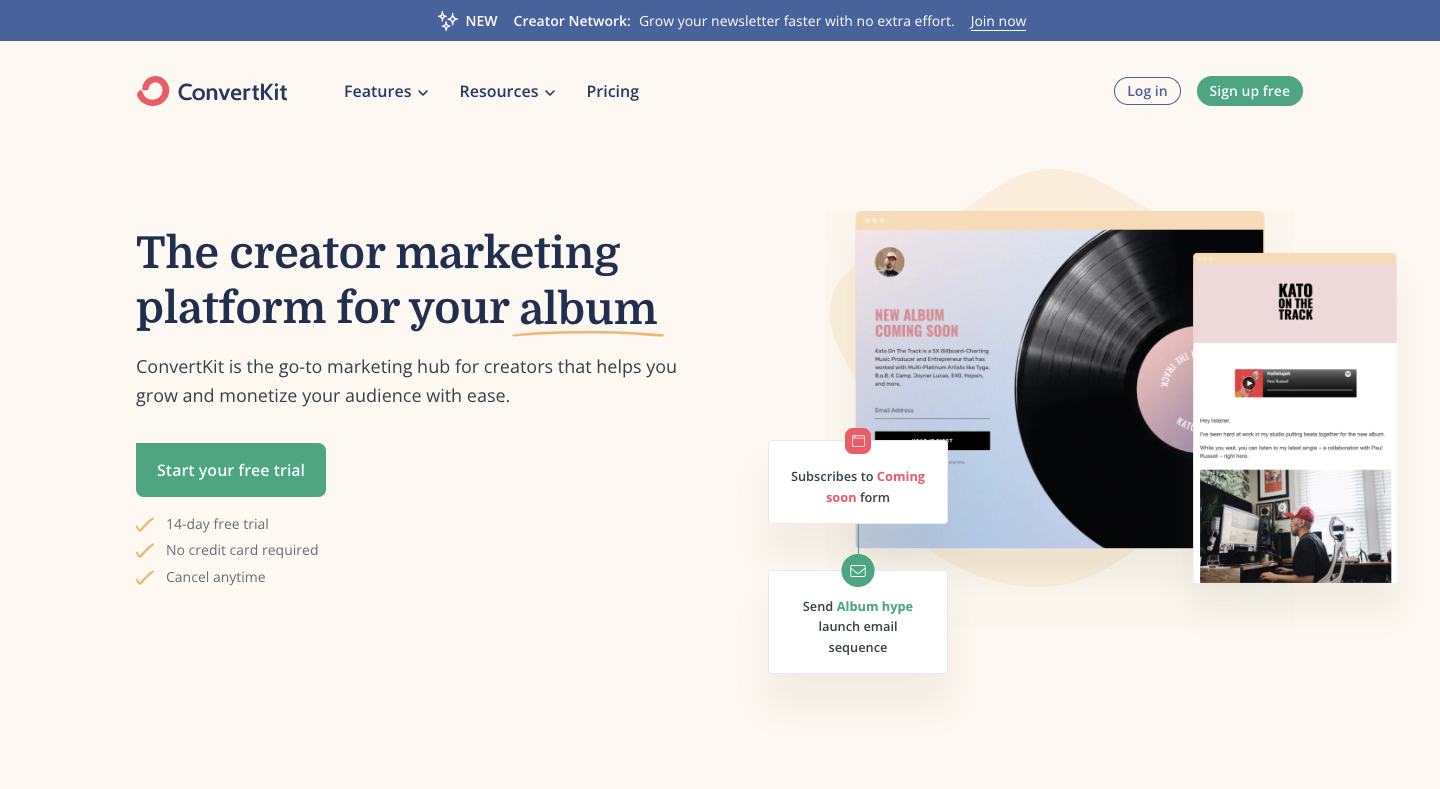 Now for something a little different. ConvertKit targets a whole other audience to any of our other GetResponse alternatives: content creators (i.e. coaches, authors, podcasters, musicians, and other creators). If that’s you, is ConvertKit the obvious fit, or should you stick with an all-rounder like GetResponse?
Now for something a little different. ConvertKit targets a whole other audience to any of our other GetResponse alternatives: content creators (i.e. coaches, authors, podcasters, musicians, and other creators). If that’s you, is ConvertKit the obvious fit, or should you stick with an all-rounder like GetResponse?
What Makes ConvertKit the Best GetResponse Alternative?
- In-platform creator network. One of ConvertKit’s most interesting features is its Creator Network, which allows creators to recommend and be recommended by other creators on the platform, giving users a simple way to grow their audience. GetResponse doesn’t have a comparable feature.
- Inclusive referral marketing. Subscribe to ConvertKit’s Creator Pro plan (starting at $25/month) to get inclusive access to SparkLoop, a referral marketing platform that offers another way to grow your audience. GetResponse integrates with a different referral platform, Referral Rock—but you’ll need to pay for a subscription (priced from $200/month).
- Built-in newsletter monetization. Provided you’ve built a list of 10,000+ followers, ConvertKit helps you find paid sponsorships for your newsletters. Unsurprisingly, you won’t get that from GetResponse, which doesn’t really cater to creators.
- More generous free plan. ConvertKit’s free plan is excellent, offering up to 1,000 contacts and unlimited landing pages, forms, and email sends. GetResponse has a solid free plan, but it’s nowhere near as generous.
How Does ConvertKit Compare to GetResponse?
| ConvertKit | GetResponse | |
| Best Feature | Integrated newsletter referral program helps creators grow their reach by leveraging their existing audience. | Built-in GPT-3.5-powered email generator. |
| Best For | Content creators | Small businesses that need advanced marketing tools |
| Pros | Lots of creator-friendly tools to grow your audience and monetize your content. | A better fit for anyone who isn’t a content creator. |
| Cons | If you’re not a content creator, ConvertKit isn’t the right choice. | Less generous free plan; no content creator-specific tools. |
| Pricing/Month | Free for up to 1,000 subscribers and unlimited email sends; paid plans start at $9 per month for up to 300 subscribers and unlimited sends. | Free for up to 500 contacts and 2,500 monthly email sends. Paid plans start at $13.30 per month for 1,000 contacts and unlimited email sends. |
| Support | Paying customers get live chat and email support, with priority access offered to Creator Pro subscribers. Free subscribers only get community support. | Paid plans include 24/7 support via chat and email. Phone support is only available at top-tier MAX2 level; some MAX2 customers can also access Slack support. |
7. ActiveCampaign
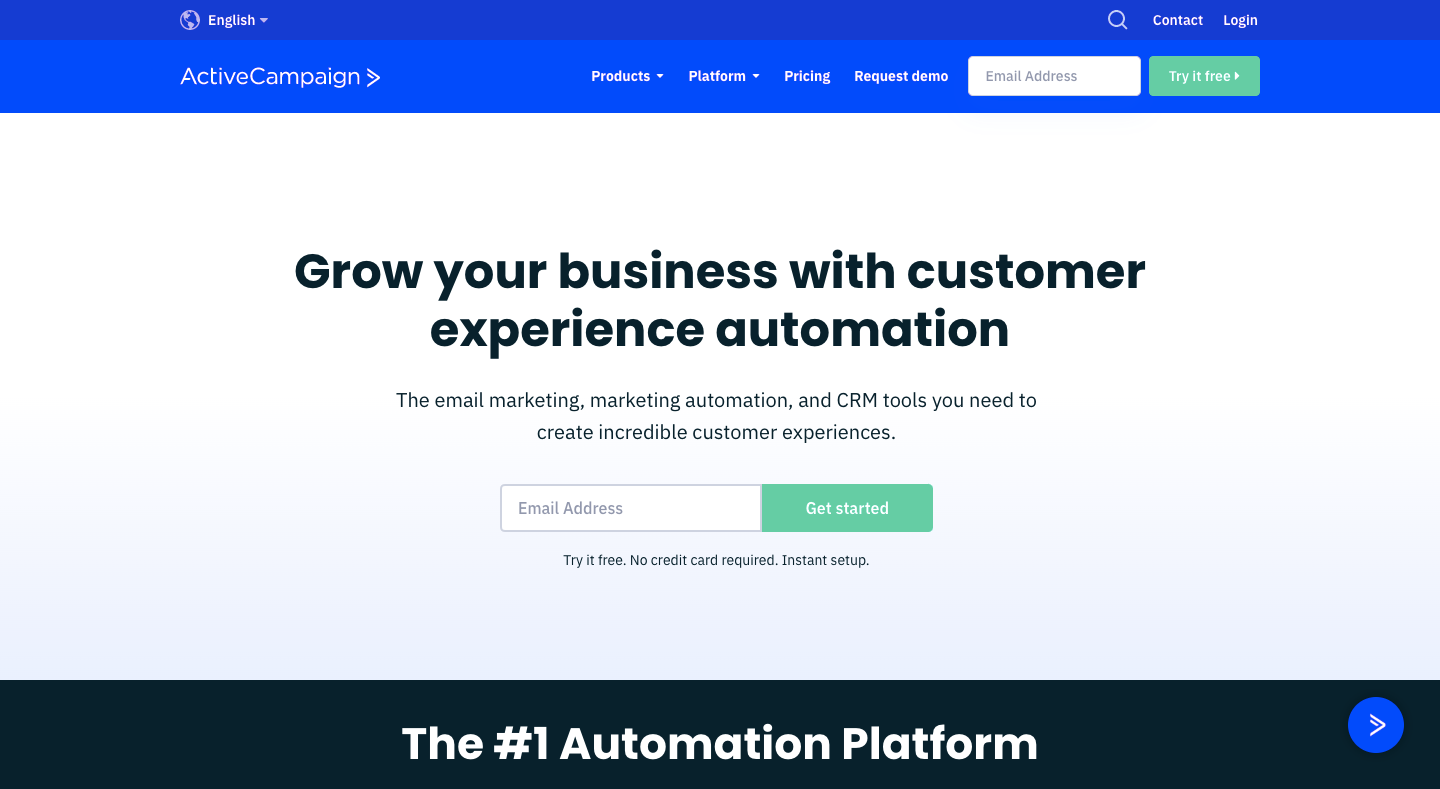 ActiveCampaign and GetResponse are two of the most feature-packed email and automation platforms on the market, offering enough tools to satisfy even the most advanced marketers. But you can’t choose both, so which should you use?
ActiveCampaign and GetResponse are two of the most feature-packed email and automation platforms on the market, offering enough tools to satisfy even the most advanced marketers. But you can’t choose both, so which should you use?
What Makes ActiveCampaign the Best GetResponse Alternative?
- Pro-quality automations for all. Every ActiveCampaign plan includes professional automations, whereas lower-tier GetResponse customers don’t get any marketing automation.
- Built-in CRM. ActiveCampaign’s Sales plans feature inclusive access to its CRM and deal pipeline tools. GetResponse doesn’t have a CRM, so you’d need to integrate with a third-party platform to enjoy the same functionality.
- Accessible SMS marketing. Unless you’re prepared to pay for GetResponse’s top-tier plan, SMS marketing is out of the question. ActiveCampaign, meanwhile, offers SMS on all but its entry-level Lite plan.
- More native integrations. ActiveCampaign has 870+ integrations—way more than you could possibly need, but reassuring nonetheless. GetResponse doesn’t have any obvious omissions from its integration library, but it “only” offers about 180.
- More advanced reporting. Both tools offer all the standard email data you’d expect, but ActiveCampaign goes a step or two further by including automation reports, live chat conversion rates, contact trends, and more. It also recommends ways you can optimize your campaigns.
How Does ActiveCampaign Compare to GetResponse?
| ActiveCampaign | GetResponse | |
| Best Feature | Predictive actions use machine learning to deliver customer experiences based on data, such as the best time to send emails. | Built-in GPT-3.5-powered email generator. |
| Best For | Advanced marketers who need high-level automation | Small businesses that need advanced marketing tools |
| Pros | Pro-quality automations available on all paid plans. | Cheaper than ActiveCampaign and still offers a ton of advanced features. |
| Cons | No free plan; generally more expensive. | Charges more for marketing automation. |
| Pricing/Month | From $29 per month for one user and unlimited emails. | Free for up to 500 contacts and 2,500 monthly email sends. Paid plans start at $13.30 per month for 1,000 contacts and unlimited email sends. |
| Support | All ActiveCampaign plans offer 24/7 email and chat-based support, but only Enterprise customers get over-the-phone support. | Paid plans include 24/7 support via chat and email. Phone support is only available at top-tier MAX2 level; some MAX2 customers can also access Slack support. |
8. AWeber
 While AWeber and GetResponse are both generalist email marketing tools, they’re at different ends of the spectrum: GetResponse is packed full of advanced tools, whereas AWeber is big on simplicity. Let’s see how they measure up…
While AWeber and GetResponse are both generalist email marketing tools, they’re at different ends of the spectrum: GetResponse is packed full of advanced tools, whereas AWeber is big on simplicity. Let’s see how they measure up…
What Makes AWeber the Best GetResponse Alternative?
- Send more emails for free. AWeber’s free plan is slightly more generous when it comes to email volume, allowing you to send 3,000 monthly emails to 500 subscribers (whereas GetResponse includes 500 subscribers and 2,500 emails per month).
- Free marketing automation. With AWeber, you can create one email automation on the free plan. By contrast, GetResponse only offers automations on its mid-tier Marketing Automation plan, priced from $59/month.
- (Slightly) cheaper prices. If all you want to do is send emails, AWeber works out a little cheaper. For instance, it charges $22.50/month for unlimited sends to 2,500 subscribers; that’d cost $29/month with GetResponse. Not a huge difference, but it all adds up.
- More integrations. AWeber integrates with over 750 third-party apps and platforms, which is way more than GetResponse. Although, again, there’s nothing obvious missing from the GetResponse integrations library, so in reality you’d likely be fine with either.
- Inclusive push notifications. All AWeber users—even those on the free plan—can run push notification campaigns, while GetResponse only offers push notifications on its Ecommerce Marketing plan (priced from $119/month) and above.
How Does AWeber Compare to GetResponse?
| AWeber | GetResponse | |
| Best Feature | Create email templates in seconds using your website or Facebook page URL. | Built-in GPT-3.5-powered email generator. |
| Best For | Startups and small businesses | Small businesses that need advanced marketing tools |
| Pros | Slightly more generous free plan; cheaper access to automations and push notifications. | More advanced analytics; better email templates and design options. |
| Cons | Reporting is pretty basic. | No marketing automation on lower-priced plans. |
| Pricing/Month | Free for up to 500 email subscribers and 3,000 monthly email sends; paid plans priced from $12.50 per month for up to 500 subscribers and unlimited emails. | Free for up to 500 contacts and 2,500 monthly email sends. Paid plans start at $13.30 per month for 1,000 contacts and unlimited email sends. |
| Support | All users—even free subscribers—can access 24/7 live support via phone, email, and chat (although paying customers are placed in a priority queue). | Paid plans include 24/7 support via chat and email. Phone support is only available at top-tier MAX2 level; some MAX2 customers can also access Slack support. |
9. Constant Contact
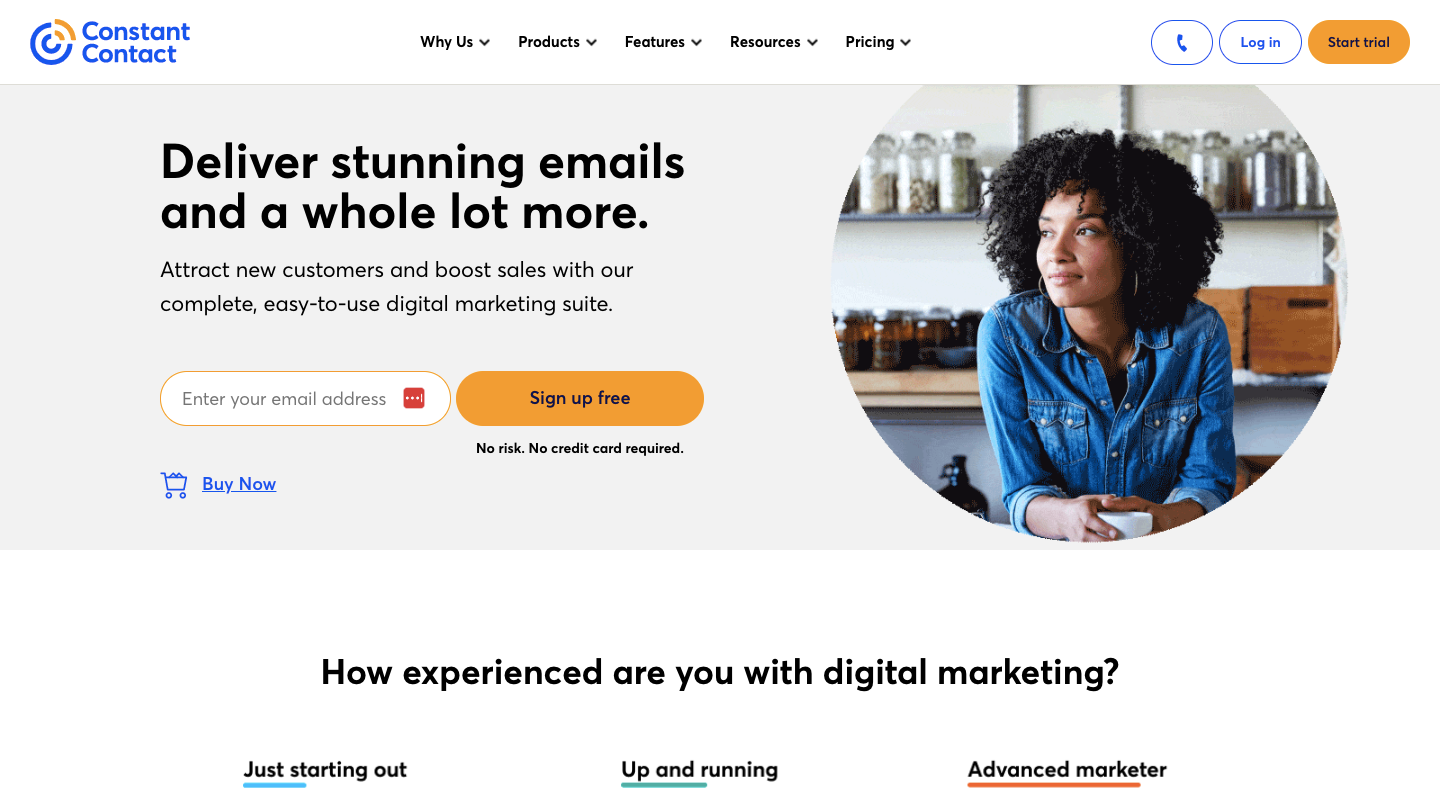 Constant Contact started out waaaay back in 1995 as a basic email marketing platform. It still does emails, but it’s added a host of additional functionality—including social media scheduling and SMS marketing—down the years. So is it the best GetResponse alternative?
Constant Contact started out waaaay back in 1995 as a basic email marketing platform. It still does emails, but it’s added a host of additional functionality—including social media scheduling and SMS marketing—down the years. So is it the best GetResponse alternative?
What Makes Constant Contact the Best GetResponse Alternative?
- Built-in social scheduling. Arguably Constant Contact’s biggest point of difference is the ability to schedule organic social posts and manage ad campaigns across multiple social platforms. GetResponse doesn’t do social media management (although it does offer a built-in social ads creator).
- Inclusive event marketing tools. Constant Contact customers get access to dedicated event marketing tools, allowing them to build registration forms, send email invites, sell tickets, and more. You’ll need an integration to do most of that stuff through GetResponse.
- Phone-based customer support. Constant Contact is one of the few platforms to offer over-the-phone support to all customers, regardless of how much they pay. GetResponse only extends that privilege to top-tier subscribers.
How Does Constant Contact Compare to GetResponse?
| Constant Contact | GetResponse | |
| Best Feature | Manage campaigns on the go from a dedicated mobile app. | Built-in GPT-3.5-powered email generator. |
| Best For | Nonprofits and charities (they save up to 30 percent on standard Constant Contact prices) | Small businesses that need advanced marketing tools |
| Pros | Built-in social media marketing and scheduling. | Better templates; more detailed reporting; slicker email editor; has its own website builder. |
| Cons | No free plan; generally more expensive (and with a weaker feature set). | Doesn’t do social scheduling. |
| Pricing/Month | From $12 per month for up to 500 contacts and 5,000 monthly email sends. | Free for up to 500 contacts and 2,500 monthly email sends. Paid plans start at $13.30 per month for 1,000 contacts and unlimited email sends. |
| Support | All plans offer live chat and phone support, while Standard and Premium customers get onboarding calls too. | Paid plans include 24/7 support via chat and email. Phone support is only available at top-tier MAX2 level; some MAX2 customers can also access Slack support. |
10. HubSpot
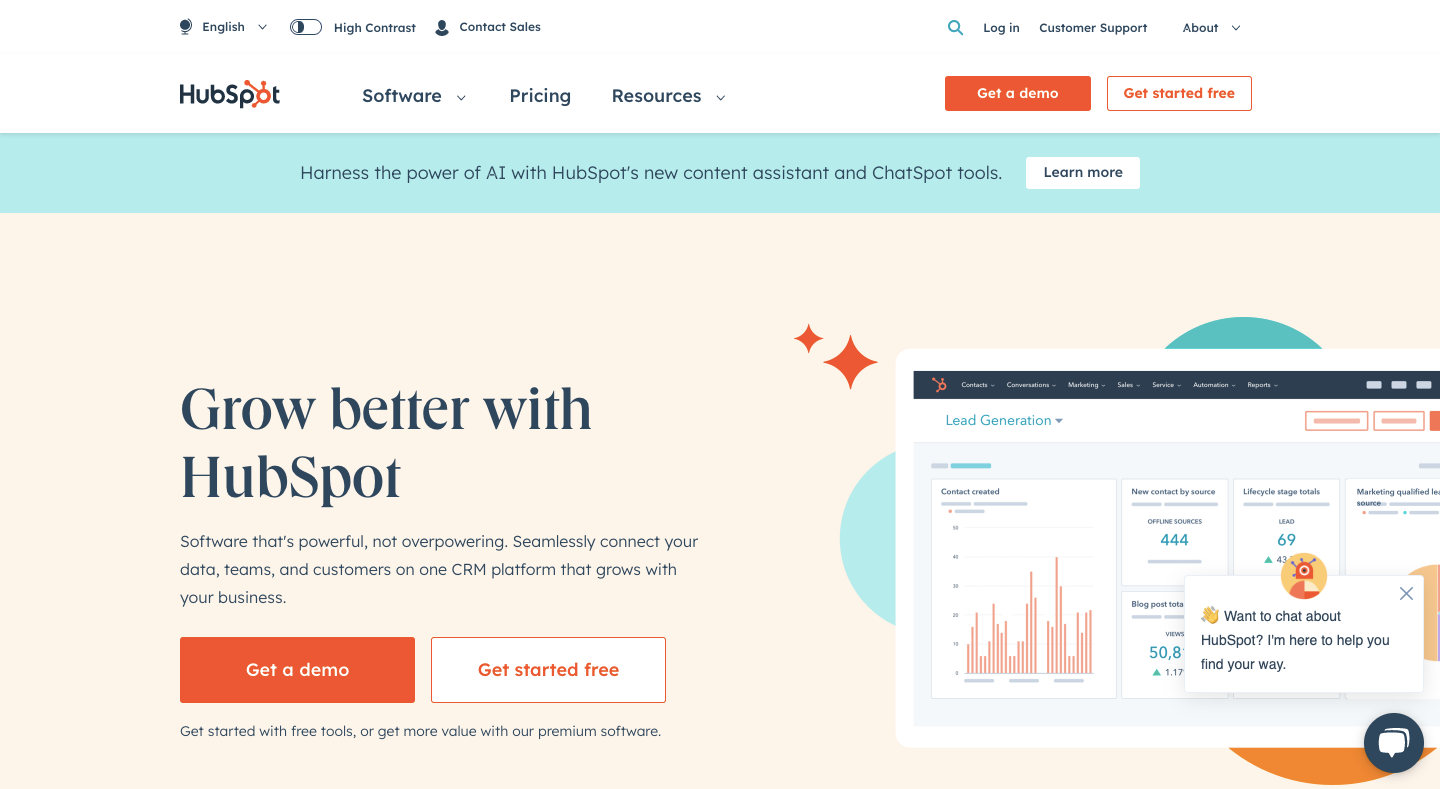 It’s hard to compare any of the other platforms in this article to HubSpot because it does so much stuff beyond email marketing. Still, you can absolutely use it to send emails (it even has a solid free plan), so let’s see how it fares against a more dedicated tool like GetResponse…
It’s hard to compare any of the other platforms in this article to HubSpot because it does so much stuff beyond email marketing. Still, you can absolutely use it to send emails (it even has a solid free plan), so let’s see how it fares against a more dedicated tool like GetResponse…
What Makes HubSpot the Best GetResponse Alternative?
- Manage multiple business functions. Far from just a marketing tool, HubSpot also combines sales, customer support, content management, and operations in a single platform. GetResponse doesn’t have anything like that level of functionality.
- Wide-ranging free plan. To be clear, HubSpot is far from the cheapest way to send emails. But it does offer an enticing free plan that includes unlimited contacts, 2,000 monthly email sends, and even limited segmentation and automations. You don’t even get automation with some of GetResponse’s paid plans.
- Built-in (free) CRM. Arguably HubSpot’s biggest strength is its superb, built-in, and totally free CRM. GetResponse doesn’t have a CRM, so it can’t compete here.
- (Way) more integrations. HubSpot integrates with over 1,000 other tools and apps, which is frankly ridiculous. GetResponse offers far fewer integrations (although, as we’ve noted, it’s not missing anything obvious).
How Does HubSpot Compare to GetResponse?
| HubSpot | GetResponse | |
| Best Feature | Connect marketing, sales, content management, and customer service in a single platform. | Built-in GPT-3.5-powered email generator. |
| Best For | B2B inbound marketing | Small businesses that need advanced marketing tools |
| Pros | An all-in-one sales and marketing platform with an excellent (free) CRM. | If you don’t need all the non-email functionality, GetResponse is much cheaper (and just as sophisticated). |
| Cons | Extremely expensive if you’re only looking for an email tool. | No built-in CRM. |
| Pricing/Month | Free marketing plan includes unlimited contacts and 2,000 monthly email sends. Paid marketing plans start at $18 per month for 1,000 contacts and 5,000 monthly sends. | Free for up to 500 contacts and 2,500 monthly email sends. Paid plans start at $13.30 per month for 1,000 contacts and unlimited email sends. |
| Support | Paying customers can get 1:1 email and in-app chat support. Phone support is available at Pro level and above. | Paid plans include 24/7 support via chat and email. Phone support is only available at top-tier MAX2 level; some MAX2 customers can also access Slack support. |
Frequently Asked Questions
GetResponse is an excellent email marketing tool, but there are definitely better alternatives for some businesses. In particular, platforms like ActiveCampaign and Brevo offer sophisticated automations at a cheaper price point. GetResponse also locks its dedicated ecommerce functionality away behind its higher-tier plans, making tools such as Drip and Omnisend a better fit for ecommerce brands.
Google doesn’t offer a GetResponse alternative, although you can use a third-party plugin to run basic email marketing campaigns through Gmail.
GetResponse is one of the best email platforms. But as a generalist tool, it’s not the best choice for everyone. If you’re a content creator, you’re better off with a dedicated platform like ConvertKit. And if you’re in ecommerce, you should choose a more revenue-centric tool like Drip, Klaviyo, or Omnisend.
GetResponse has a couple of noteworthy weak points. In particular, it charges more money for essential ecommerce marketing features (like transactional emails and ecommerce segmentation). And you don’t get access to professional-grade marketing automation at lower price points.
Conclusion
Sure, GetResponse is a competitor, but we’d genuinely recommend it to anyone looking for an all-purpose email marketing platform.
However, if you’re in ecommerce, you’ll be much better off with a specialist platform like Drip.
Every Drip customer can access our pro-quality automations, workflows, templates, and segmentation features, giving you all the tools you need to grow your audience, capture more ecommerce leads, and generate more sales and revenue.
Find out for yourself by signing up for your 14-day free trial today!
